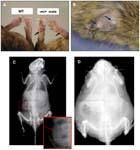Phenotypes associated with this allele
Allelic
Composition |
Gnastm1Gwa/Gnas+
|
|
Genetic
Background |
either: (involves: 129S4/SvJae * 129/Sv) or (involves: 129S4/SvJae * C57BL/6J) or (involves: 129S4/SvJae * CD-1) |
|
| Find Mice |
Using the International Mouse Strain Resource (IMSR)
Mouse lines carrying:
Gnastm1Gwa mutation
(0 available);
any
Gnas mutation
(66 available)
|
|
|
behavior/neurological
|
|
• mutants have a lower intake of ethanol than wild-type mice when given 24 hour access to feeding tubes containing water or water with 3% ethanol or when ethanol content is increased to 6, 10 and 20% every three days; genetic background shows no effect on phenotype
|
Allelic
Composition |
Gnastm1Gwa/Gnas+
|
|
Genetic
Background |
involves: 129S/SvEv * 129S4/SvJae |
|
| Find Mice |
Using the International Mouse Strain Resource (IMSR)
Mouse lines carrying:
Gnastm1Gwa mutation
(0 available);
any
Gnas mutation
(66 available)
|
|
|

Subcutaneous ossifications in Gnastm1Gwa/Gnas+ mice
growth/size/body
integument
|
|
• mutants, regardless of whether the allele is maternally or paternally inherited, develop extensive and progressive subcutaneous ossifications
• females exhibit fewer ossifications at all times examined than males
|
|
|
• mutants, regardless of whether the allele is maternally or paternally inherited, develop extensive and progressive subcutaneous ossifications, with rare lesions in the dermis and subcutis at 3 months but very common at 12 months
• 12 month old mutants exhibit erythemateous and mildly erosive footpad lesions
• occasionally mice exhibit nodular subcutaneous ear lesions, always near the site of ear tags that are not seen in wild-type mice, indicating that areas of pressure and trauma develop ossifications
• at 12 months of age, lesions are more severe in males than females for both maternally and paternally inherited alleles
|
skeleton
|
|
• heterotopic bone formation is seen in the skin and is often associated with a dense eosinophilic osteoid-like matrix in the dermis and perifollicular areas
• subcutaneous ossifications are mineralized and express osteoblast markers and appear to originate near the hair follicle
• males have more severe and widespread heterotopic bone in the subcutaneous tissue than female mice
|
Allelic
Composition |
Gnastm1Gwa/Gnas+
|
|
Genetic
Background |
involves: 129S4/SvJae * C57BL/6J |
|
| Find Mice |
Using the International Mouse Strain Resource (IMSR)
Mouse lines carrying:
Gnastm1Gwa mutation
(0 available);
any
Gnas mutation
(66 available)
|
|
|
behavior/neurological
|
|
• mutants take twice as long to regain their righting reflex as wild-type in response to sedative effects of ethanol
|
homeostasis/metabolism



 Analysis Tools
Analysis Tools